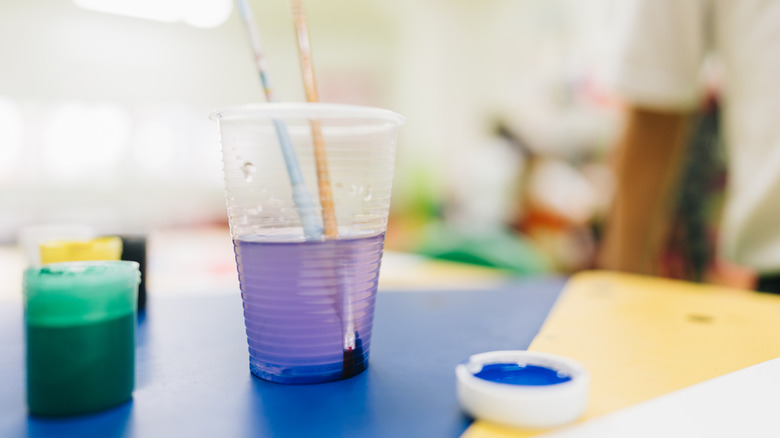The Common Disposal Mistake That's Damaging Your Pipes And Could Be Harming Wildlife
If you love painting, you most likely have a container of cloudy, colorful water sitting nearby. Using acrylic paint to fill your home with art you love is a terrific hobby, but what are you supposed to do with that paint water after? The easy solution might seem to be to just pour it down the drain, but that's a serious mistake that can have major consequences for your plumbing and the environment. Letting the paint water settle instead and wiping the solids out later is the way to go.
The thing to understand here is that acrylic paint is pretty much just liquid plastic. When you rinse your paint water container, you release tons of microplastics into your plumbing system. While the water disappears, these tiny solids stick to the inside of your pipes. Over time, they gradually harden, leading to stubborn clogs that reduce the lifespan of your pipes. And that won't be just a minor issue; it'll be a seriously costly repair down the line. You don't want the time to replace your pipes to be today.
But the danger doesn't stop at the pipes. Paint water flushed into the sewage system also contains various chemicals and, in some cases, color-enhancing heavy metals like cadmium (usually listed on the paint label) that can be difficult to filter at water treatment plants. From there, these substances find their way into rivers, lakes, and oceans. Once in natural waterways, they not only taint the water we use but also pose a threat to aquatic life. Small organisms may consume the microplastics, moving it up the food chain, while the chemicals directly pollute fragile ecosystems. Opting for the simple convenience of pouring paint water down the sink in the moment can contribute to a true environmental hazard.
The correct, easy steps to responsible paint water disposal
Fortunately, protecting your pipes and the planet from acrylic paint is a cinch, and these are our two favorite options (and both are inexpensive). First up is a coffee filter. With this, all you need to do is pour the paint water through the filter; you can do this over a sink, into another container, or even out in your backyard. The filter lets the water pass through while catching the paint solids; just toss the filter when you're done.
Alternatively, use the kitty litter method. Litter has myriad uses around the house, so it's no surprise it works well for disposing of paint water, too. For it, take a container (sized according to how much you paint; for example, a five-gallon bucket for regular artists), put some clumping kitty litter at the bottom (6-8 inches for that five-gallon bucket), then dump your water in there. It'll clump as it absorbs the water, then just scoop it up and toss it.
The final step is handling the remaining paint sludge. With the water now poured out, you are left with a small, thick concentration of paint at the bottom of your container. Take a paper towel and wipe out all the leftover sediment, then toss the paper towel into the garbage. Disposing of old paint the right way (if you're done with your project) is also easy. And by isolating the solid paint waste and disposing of it responsibly, you ensure the microplastics and chemicals go to a landfill where they're contained in a less-harmful manner, rather than clogging your home or polluting waterways. Nothing's more picture perfect than that!

